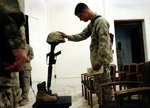I was impressed with syscom3's thread on the 'Napalm Girl', Kim Phuc, and the associated Pulitzer prize photo. I'm hoping to start a long thread showing many of these award winning photos and the stories behind them. Please contribute.
In no particular order I'm starting with 'The Vulture and the Baby' of 1994.

Taken by Kevin Carter in the Sudan. Stopping in Ayod he was photographing horrific scenes of starving people and came across this little girl making her way to a feeding station. At that moment, a vulture landed nearby, sensing carrion. Carter snapped some photos and chased the bird away.
Carter's friends later reported that he was depressed after making the picture, but the poignant image touched a global nerve. In March, the New York Times, seeking a photo from Sudan, used Carter's gut-wrenching picture. It was quickly picked up by others and widely published internationally; it soon became a worldwide icon of African suffering.
Personal tragedies followed Carter and there was stinging criticism of his photo. Some believed that it was a fluke or that he had somehow set it up. Others described him as the vulture for taking the photograph.
On the night of July 28, 1994, shortly after being presented with the Pulitzer award Carter committed suicide in Johannesburg. The explanatory note he left behind told of a man frustrated by lack of money and haunted by the unrelenting memories of killings, madmen with guns, starving children, of corpses and pain. He was 33 years old.
In no particular order I'm starting with 'The Vulture and the Baby' of 1994.

Taken by Kevin Carter in the Sudan. Stopping in Ayod he was photographing horrific scenes of starving people and came across this little girl making her way to a feeding station. At that moment, a vulture landed nearby, sensing carrion. Carter snapped some photos and chased the bird away.
Carter's friends later reported that he was depressed after making the picture, but the poignant image touched a global nerve. In March, the New York Times, seeking a photo from Sudan, used Carter's gut-wrenching picture. It was quickly picked up by others and widely published internationally; it soon became a worldwide icon of African suffering.
Personal tragedies followed Carter and there was stinging criticism of his photo. Some believed that it was a fluke or that he had somehow set it up. Others described him as the vulture for taking the photograph.
On the night of July 28, 1994, shortly after being presented with the Pulitzer award Carter committed suicide in Johannesburg. The explanatory note he left behind told of a man frustrated by lack of money and haunted by the unrelenting memories of killings, madmen with guns, starving children, of corpses and pain. He was 33 years old.









